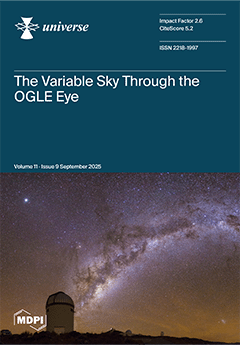The present work discusses the birth of the Universe via quantum tunneling through a potential barrier, based on quantum cosmology, taking a running cosmological constant into account. We consider the Friedmann–Lemaître–Robertson–Walker (FLRW) metric with positively curved spatial sections (
) and the matter’s content is a dust perfect fluid. The model was quantized by the Dirac formalism, leading to a Wheeler–DeWitt equation. We solve that equation both numerically and using a WKB approximation. We study the behavior of tunneling probabilities
and
by varying the energy
E of the dust perfect fluid, the phenomenological parameter
, the present value of the Hubble function
, and the constant energy density
, with the last three parameters all being associated with the running cosmological constant. We observe that both tunneling probabilities,
and
, decrease as one increases
. We also note that
and
grow as
E increases, indicating that the Universe is more likely to be born with higher dust energy
E values. The same is observed for the parameter
, that is,
and
are larger for higher values of
. Finally, the tunneling probabilities decrease as one increases the value of
. Therefore, the best conditions for the Universe to be born, in the present model, would be to have the highest possible values for
E and
and the lowest possible values for
and
.
Full article





